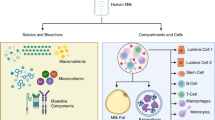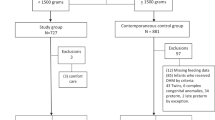Abstract
Donor human milk is recommended by the American Academy of Pediatrics for high-risk infants when mother’s own milk is absent or insufficient in quantity. Several factors may contribute to the inequitable use of or access to donor human milk, including a limited knowledge of its effects, cost, reimbursement, and regulatory barriers. The American Academy of Pediatrics and the United States Surgeon General have called for investigating barriers that prevent use of donor human milk for high-risk infants and for changes to public policy known to improve availability and affordability. We review the current legislative, regulatory, and economic landscape surrounding donor human milk use in the United States, as well as suggest state- and federal-level solutions to increase access to donor human milk.
This is a preview of subscription content, access via your institution
Access options
Subscribe to this journal
Receive 12 print issues and online access
$259.00 per year
only $21.58 per issue
Buy this article
- Purchase on SpringerLink
- Instant access to full article PDF
Prices may be subject to local taxes which are calculated during checkout

Similar content being viewed by others
References
Ip S, Chung M, Raman G, Chew P, Magula N, DeVine D, et al. Breastfeeding and maternal and infant health outcomes in developed countries. Evid Rep Technol Assess Full Rep. 2007;153:1–186.
Section on B. Breastfeeding and the use of human milk. Pediatrics. 2012;129:e827–841.
Chetta KE, Schulz EV, Wagner CL. Outcomes improved with human milk intake in preterm and full-term infants. Semin Perinatol. 2021;45:151384.
Miller J, Tonkin E, Damarell RA, McPhee AJ, Suganuma M, Suganuma H, et al. A systematic review and meta-analysis of human milk feeding and morbidity in very low birth weight infants. Nutrients 2018;10:707.
Organization WH. Optimal feeding of low birth-weight infants in low-and middle-income countries. 2011. https://www.who.int/elena/titles/donormilk_infants/en/.
Nutrition ECo, Arslanoglu S, Corpeleijn W, Moro G, Braegger C, Campoy C, et al. Donor human milk for preterm infants: current evidence and research directions. J Pediatr Gastroenterol Nutr. 2013;57:535–42.
Committee on Nutrition, Section on Breastfeeding, Committee on Fetus and Newborn. Donor human milk for the high-risk infant: preparation, safety, and usage options in the United States. Pediatrics. 2017;139:e20163440.
Quigley M, Embleton ND, McGuire W. Formula versus donor breast milk for feeding preterm or low birth weight infants. Cochrane Database Syst Rev. 2019;7:CD002971.
Parker MG, Stellwagen LM, Noble L, Kim JH, Poindexter BB, Puopolo KM, et al. Promoting human milk and breastfeeding for the very low birth weight infant. Pediatrics. 2021;148:e2021054272.
Schmaltz CH, Bouchet-Horwitz J, Summers L. Advocating for pasteurized donor human milk: the journey for medicaid reimbursement in New York State. Adv Neonatal Care. 2019;19:431–40.
Jones F, Human Milk Banking Association of North A. History of North American donor milk banking: one hundred years of progress. J Hum Lact. 2003;19:313–8.
Nolan LS, Parks OB, Good M. A review of the immunomodulating components of maternal breast milk and protection against necrotizing enterocolitis. Nutrients. 2019;12:14.
O’Connor DL, Gibbins S, Kiss A, Bando N, Brennan-Donnan J, Ng E, et al. Effect of supplemental donor human milk compared with preterm formula on neurodevelopment of very low-birth-weight infants at 18 months: a randomized clinical trial. JAMA. 2016;316:1897–905.
Cognata A, Kataria-Hale J, Griffiths P, Maskatia S, Rios D, O’Donnell A, et al. Human milk use in the preoperative period is associated with a lower risk for necrotizing enterocolitis in neonates with complex congenital heart disease. J Pediatr. 2019;215:11–16 e12.
Hoban R, Khatri S, Patel A, Unger SL. Supplementation of mother’s own milk with donor milk in infants with gastroschisis or intestinal atresia: a retrospective study. Nutrients. 2020;12:589.
McKittrick MM, Khaki S, Gievers L, Larson IA. Clinical and sociodemographic factors associated with human donor milk supplementation in term newborns. Hosp Pediatr. 2020;10:489–95.
McCune S, Perrin MT. Donor human milk use in populations other than the preterm infant: a systematic scoping review. Breastfeed Med. 2021;16:8–20.
Hagadorn JI, Brownell EA, Lussier MM, Parker MG, Herson VC. Variability of criteria for pasteurized donor human milk use: a survey of U.S. neonatal intensive care unit medical directors. JPEN J Parenter Enter Nutr. 2016;40:326–33.
Stey A, Barnert ES, Tseng CH, Keeler E, Needleman J, Leng M, et al. Outcomes and costs of surgical treatments of necrotizing enterocolitis. Pediatrics. 2015;135:e1190–1197.
Kantorowska A, Wei JC, Cohen RS, Lawrence RA, Gould JB, Lee HC. Impact of donor milk availability on breast milk use and necrotizing enterocolitis rates. Pediatrics. 2016;137:e20153123.
Johnson TJ, Patel AL, Bigger HR, Engstrom JL, Meier PP. Cost savings of human milk as a strategy to reduce the incidence of necrotizing enterocolitis in very low birth weight infants. Neonatology. 2015;107:271–6.
Johnson TJ, Berenz A, Wicks J, Esquerra-Zwiers A, Sulo KS, Gross ME, et al. The economic impact of donor milk in the neonatal intensive care unit. J Pediatr. 2020;224:57–65 e54.
Trang S, Zupancic JAF, Unger S, Kiss A, Bando N, Wong S, et al. Cost-effectiveness of supplemental donor milk versus formula for very low birth weight infants. Pediatrics. 2018;141:e20170737.
Parker MG, Barrero-Castillero A, Corwin BK, Kavanagh PL, Belfort MB, Wang CJ. Pasteurized human donor milk use among US level 3 neonatal intensive care units. J Hum Lact. 2013;29:381–9.
Perrine CG, Scanlon KS. Prevalence of use of human milk in US advanced care neonatal units. Pediatrics. 2013;131:1066–71.
Perrin MT. Donor human milk and fortifier use in United States level 2, 3, and 4 neonatal care hospitals. J Pediatr Gastroenterol Nutr. 2018;66:664–9.
Parker MG, Burnham LA, Kerr SM, Belfort MB, Perrin MT, Corwin MJ, et al. National prevalence of donor milk use among level 1 nurseries. Hosp Pediatr. 2020;10:1078–86.
Parker MG, Burnham LA, Kerr S, Belfort MB, Perrin M, Corwin M, et al. Prevalence and predictors of donor milk programs among U.S. advanced neonatal care facilities. J Perinatol. 2020;40:672–80.
Human Milk Banking Association of North America. Nonprofit milk banks celebrate modest growth, despite pandemic. 2021. https://www.hmbana.org/news/nonprofit-milk-banks-celebrate-modest-growth-despite-pandemic.html.
Office of the Surgeon General (US); Centers for Disease Control and Prevention (US); Office of Women’s Health (US). The surgeon general’s call to action to support breastfeeding. Rockville (MD): The Surgeon General’s Call to Action to Support Breastfeeding; 2011.
Bennett CJ, Mannel R. A call for medicaid coverage of pasteurized donor milk for foster children. J Hum Lact. 2020;36:86–90.
Ky. Rev. Stat. Ann. § 304.17A-139. https://perma.cc/Y48J-VG6J.
FirstChoice by Select Health of South Carolina. Clinical Policies. 2020. https://www.selecthealthofsc.com/provider/resources/shsc-clinical-policies.aspx.
Markus AR, Krohe S, Garro N, Gerstein M, Pellegrini C. Examining the association between Medicaid coverage and preterm births using 2010–2013 National Vital Statistics Birth Data. J Child Poverty. 2016;23:79–94.
Martin JA, Hamilton BE, Osterman MJK, Driscoll AK. Births: final data for 2019. Natl Vital Stat Rep. 2021;70:1–51.
Goldstein GP, Pai VV, Liu J, Sigurdson K, Vernon LB, Lee HC, et al. Racial/ethnic disparities and human milk use in necrotizing enterocolitis. Pediatr Res. 2020;88:3–9. (Suppl 1)
Arnold LD. U.S. health policy and access to banked donor human milk. Breastfeed Med. 2008;3:221–9.
Patient Protection and Affordable Care Act, 42 U.S.C. § 300gg-13 (2021), 29 C.F.R. 2590.715-2713 (2021), Health Resources & Services Administration, Women’s Preventive Services Guidelines. https://www.hrsa.gov/womens-guidelines-2019. Accessed on 9 Sept 2021.
Shah S, Parvez B, Brumberg HL. Ensuring breastfeeding-supportive legislation. Pediatr Res. 2017;81:394–5.
Patient Protection and Affordable Care Act § 4207, amending the Fair Labor Standards Act and codified at 29 U.S.C.A. § 207(r) (2021). https://perma.cc/HD3E-PQZ5.
Food and Nutrition Service USDoA. Special supplemental nutrition program for women, infants, and children (WIC). 2021. https://www.fns.usda.gov/wic.
Food and Nutrition Service USDoA. Breastfeeding is a priority in the WIC program. 2021. https://www.fns.usda.gov/wic/breastfeeding-priority-wic-program.
Food and Nutrition Service USDoA. Use of banked human breastmilk (BBM) in the WIC program. 2000. https://www.fns.usda.gov/wic/use-banked-human-breastmilk-bbm-wic-program.
Therapeutics FaDAOoP, Staff PMH. FDA advisory committee discusses safety of human milk banks. AAP N. 2011;32:6–6.
Tricare. Banked donor breast milk. 2020. https://www.tricare.mil/CoveredServices/IsItCovered/BankedDonorMilk.
Marinelli KA, Lussier MM, Brownell E, Herson VC, Hagadorn JI. The effect of a donor milk policy on the diet of very low birth weight infants. J Hum Lact. 2014;30:310–6.
Williams T, Nair H, Simpson J, Embleton N. Use of donor human milk and maternal breastfeeding rates: a systematic review. J Hum Lact. 2016;32:212–20.
Patel AL, Johnson TJ, Meier PP. Racial and socioeconomic disparities in breast milk feedings in US neonatal intensive care units. Pediatr Res. 2021;89:344–52.
An Act to Create the Arkansas Breast Milk Bank; To Create the Breast Milk Bank Special Fund; And For Other Purposes; 2021 Arkansas Laws Act 255, § 1, codified at Ark. Code Ann. § 20-7-140 (West 2021). https://perma.cc/6JRA-XUCQ.
Shah S, Brumberg HL, Kuo A, Balasubramaniam V, Wong S, Opipari V. Academic advocacy and promotion: how to climb a ladder not yet built. J Pediatr. 2019;213:4–7 e1.
Earnest MA, Wong SL, Federico SG. Perspective: physician advocacy: what is it and how do we do it? Acad Med. 2010;85:63–67.
United States Department of Health and Human Services (US DHHS); Centers for Disease Control and Prevention (CDC); National Center for Health Statistics (NCHS); Division of Vital Statistics. Natality public-use data 2007–2019, on CDC WONDER Online Database. 2020. https://wonder.cdc.gov/natality-current.html.
Acknowledgements
We are most grateful for the assistance of Pam Brannon, Georgia State University College of Law Coordinator of Faculty Services, and student research assistants Madison Hayes, Colin Daniels, and Kevin Schukle as well as Jennifer Williams, RN INCLC, Andrea K. Welker, J.D, M.A., and the Child Advocacy Today CAT Legal Clinical Program. In addition we would like to thank the American Academy of Pediatrics Section on Neonatal-Perinatal Medicine for grant support to the Georgia Chapter of the American Academy of Pediatrics to advocate for Medicaid coverage of donor human milk in Georgia.
Author information
Authors and Affiliations
Contributions
SIS and RMP conceived the manuscript subject. ATR and ERM equally contributed to the main conceptual ideas, drafted the manuscript with contribution and critical revisions from all authors. MB devised the legal search strategy, reviewed, collated, and interpreted results. All authors discussed the results, edited, and approved the final manuscript.
Corresponding author
Ethics declarations
Competing interests
RMP and ATR receive salary support from the NEC Society for a PCORI-funded capacity-building and research prioritization award on NEC. RMP serves on the data monitoring committee for IBT Therapeutics and Premier Research. JHK is a paid consultant for Fujifilm and serves as a medical advisor for Medela. He is on the Board of Directors for Innara Health and owns shares in Astarte Medical and Nicolette. All other authors declare no competing interests.
Additional information
Publisher’s note Springer Nature remains neutral with regard to jurisdictional claims in published maps and institutional affiliations.
Supplementary information
Rights and permissions
About this article
Cite this article
Rose, A.T., Miller, E.R., Butler, M. et al. US state policies for Medicaid coverage of donor human milk. J Perinatol 42, 829–834 (2022). https://doi.org/10.1038/s41372-022-01375-9
Received:
Revised:
Accepted:
Published:
Issue date:
DOI: https://doi.org/10.1038/s41372-022-01375-9
This article is cited by
-
Maternity care practices supportive of breastfeeding in U.S. advanced neonatal care units, United States, 2022
Journal of Perinatology (2024)
-
Medicaid and newborn care: challenges and opportunities
Journal of Perinatology (2023)
-
Advocacy in neonatology: current issues and introduction to the series
Journal of Perinatology (2023)



